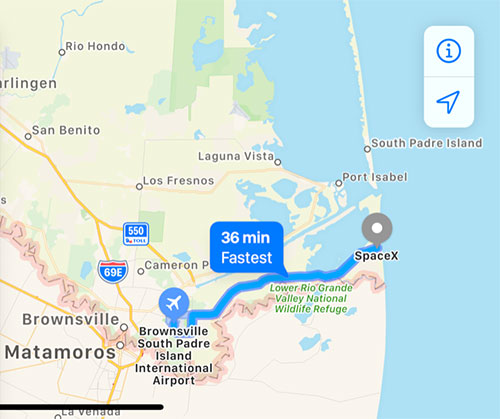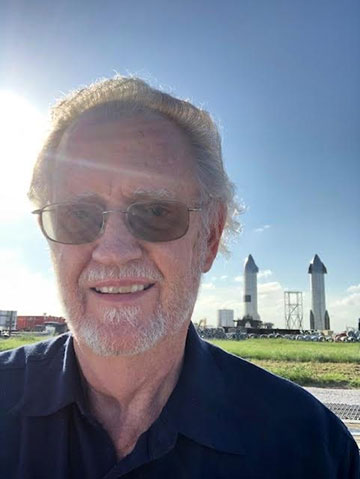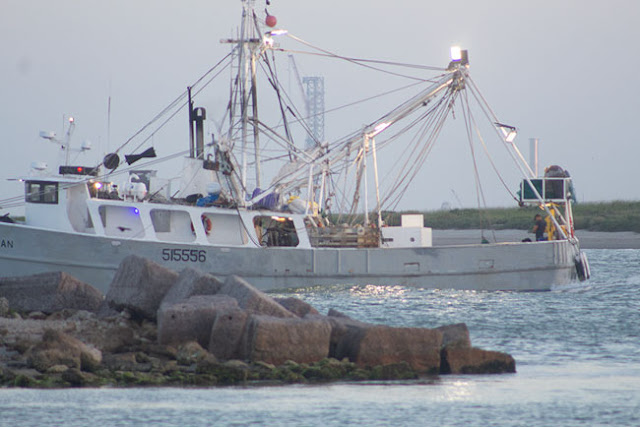Greetings from Palmia Observatory
Well this blog post covers the first day of our exploration trip to Boca Chica to check out all of the SpaceX activity with Starship and Booster, BN4 status and integration at the orbital launch tower.
So, just in case you have been living under a SpaceX less rock, Boca Chica fab and test facility is at the southern most end of Texas and provides a clear rocket launch path straight out over the Gulf of Mexico.
The SpaceX location in Boca Chica is just a short 36 minute auto ride from Brownsville Airport.
 |
| Fly into Brownsville, TX and drive to SpaceX in Boca Chica (Source: Palmia Observatory) |
I made the drive on Monday afternoon after getting off the plane and wanted to first of all get some almost obligatory shots of me in front of the Starbase sign.
 |
| Resident Astronomer takes a selfie in front of Starbase (Source: Palmia Observatory) |
Another selfie is called for with the two surviving Starship prototypes, one of which SN16, actually completed a test hop.
 |
| Resident Astronomer takes a selfie with two surviving Starships (Source: Palmia Observatory) |
My plan was to just do a cursory drive through the State Route 4 to the end at the beach and just get a sense of all the new construction and activity since we were there way back in March 16, 2020, which you can check out at: http://www.palmiaobservatory.com/2020/03/last-physics-colloquia-for-while-hooray.html
The first thing that was apparent was that now there is so much more traffic and so many more construction worker vehicles parked along the road that I felt like I was driving through a gauntlet of vehicles with just barely enough clearance for two opposing vehicles to get by.
I got to the end of the road, which ends in the beach, and just barely had a couple of car lengths to turn around before needing to venture out on the beach sand. Approaching the east end of the launch site there was a little more open space which was a construction laydown yard. You can see the two Starlink tracking antennas on the right and the ground systems equipment and launch pads on the left.
 |
| Coming back from the beach, looking westward toward the launch site (Source: Palmia Observatory) |
Here is the earlier booster version, BN2, on its test stand after completing a static fire test. The real booster that will be used for the first suborbital flight is BN4, which was just finishing up fabrication in the high bay building.
 |
| SpaceX Super Heavy Booster BN2 on test stand (Source: Palmia Observatory) |
Ok, I was glad to get out of the tight and heavy traffic pattern and besides I wanted to get over to South Padre Island (SPI) before the sun went down and check out some possible launch viewing sites from there. It is about an hour drive from Boca Chica to SPI and along the way there are many shipyards along the Brownsville Ship Channel. I was surprised to see an old Navy ship LHA-4, USS Nassau, which had been decommissioned in 2011 and was being salvaged there.
 |
| LHA-4 superstructure visible in shipyard on route to South Padre Island (Source: Palmia Observatory) |
I remember working with some electronic systems that could have installed onboard this class of Navy ship, so it was interesting to find a photo of the LHA-4 in her better younger days.
 |
| USS Nassau, LHA-4 (Source: Wikipedia) |
Ok, after the hour drive and then winding my way down to the southern tip of South Padre Island and paying the $12 entry fee to the Cameron County Park located there, I was able to scout out some of the possible viewing sites for future launches. In this cell phone photo taken at the boat ramp located there you can just barely see the SpaceX launch site and fabrication site in the distance across the channel. You can just barely make out the launch tower and other equipent. You can see the DSLR camera and flimsy tripod setup in the frame also.
 |
| Possible viewing at tip of South Padre Island for SpaceX launches (Source: Palmia Observatory) |
Well, my first look at the DSLR Liveview screen, which was quite difficult to see because of the bright sunlight. Most of of photo experience is taking photos at night when the sky is dark so I was not experienced in focusing or using the camera in bright daylight. But the bigger surprise was that the DSLR image was very dim and cloudy, not at all as clear as just using your eyeballs or cell phone. What is going on? I should have recognized what was going on because everytime I got out of the car, I had to pause a bit and let my glasses unfog. It took a while to realize that the camera had been in the back seat of an air conditioned automobile and the lens was clouded up with condensate.
 |
| First view of SpaceX launch site as seen from SPI, DSLR, 250mm, 1/500 second (Source: Palmia Observatory) |
So, what to do? Well, I just used my pocket mask to wipe off the condensate. This next DSLR image looked much better with a clear view of the launch tower and Super Heavy BN2 at the right side.
 |
| View of SpaceX launch site from SPI, DSLR, 300mm, 1/125 second (Source: Palmia Observatory) |
This location is right at the mouth to the Brownsville Ship Channel so you are subject to all sorts of boats and other watercraft passing by. Here a fishing boat competes for attention even though the launch tower is still visible.
 |
| Watch out for fishing boats that intervene, DSLR, 300mm, 1/125 second (Source: Palmia Observatory) |
Another lesson learned during this little observation scouting location was that it was hard to focus the camera in bright daylight. I was used to just using the Liveview LCD screen, but with bright sunshine it was hard to do. But the camera comes with a optical viewfinder too, which I have never used, but it includes a tight fitting ring that you can just put your eyeball next to and use it to block out the bright sun.
Anyway, that is about it for day one of our scouting exercise at SpaceX operations in Boca Chica and now was the time to find my way to the hotel for the night and check out the local margaritas and Texmex.
Until next time,

No comments:
Post a Comment